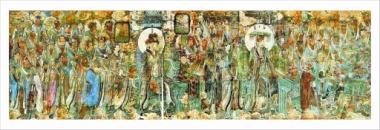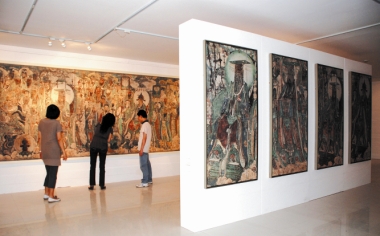|


Debra Li
FOR aficionados of Chinese art, the murals in the Yongle Palace have a special cachet.
Dating to the 14th century, they fill four halls in a Taoist temple complex with deities and scenes from everyday life, a swirling mixture of gods, demons and people. And the scale makes them awe-inspiring: Covering 960 square meters, they form the biggest single ensemble of murals in China.
Honoring one of China’s most popular gods, Lu Dongbin, the Yongle Palace was relocated between 1959 and 1964 to make way for a reservoir. Today, it is in the suburbs of Ruicheng City in Shanxi Province.
For the first time, high-fidelity replicas of the best examples of the murals are being shown in Shenzhen with the cooperation of Artron Art Gallery and the Yongle Palace Art Museum.
The replicated section, called “Chaoyuantu” (Pictures of Paying Homage to the Origin), comes from the Hall of the Three Pure Ones, the largest and most awe-inspiring of the four halls. The original murals are believed to have been painted by a team of Yuan Dynasty (1271-1368) artists led by Ma Junxiang and Ma Qi from Luoyang.
“Chaoyuantu” contains numerous gods in the Taoist pantheon, which makes it a cornucopia of Chinese figurative painting. There are serene goddesses, obedient attendants and argumentative followers. Several men seem engaged in a heated discussion; two men lock eyes in debate, while others strike poses of contemplation and detachment.
Jinmu (Gold Mother Goddess), probably the temple’s most famous image, is from this section. She stands serenely in flowing robes, a crown on her head adorned with the symbol for kun (female).
For audiences to better understand the murals, there are detailed explanations of the figures in the picture on a much smaller replica of “Chaoyuantu.” Featured individuals and group images are represented half the original size in separate pictures.
“We used a special scanner to capture each part of the original in Shanxi and remade them into a complete picture with computer technology. Then we compared our replica with the original and made minor adjustments until they look very much the same,” introduced an Artron docent.
“You can not see clearly even when you visit the temple in Shanxi. The original murals are dimly lit to protect them,” she said.
The mural replicas will show until the end of this month.
Also showing at Artron Art Gallery are replicas of ancient Chinese paintings and calligraphy in the collections of museums all over China, including Taipei.
Another exhibition features 10 modern and contemporary Chinese painting masters like Qi Baishi, Huang Binhong, Lin Fengmian and Wu Changshuo.
Admission is free to all shows.
|

